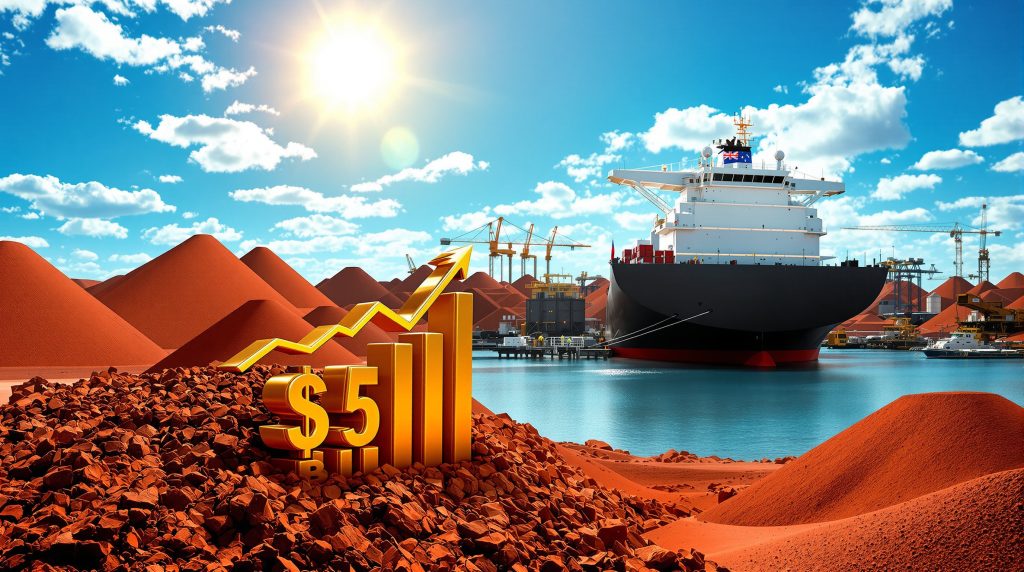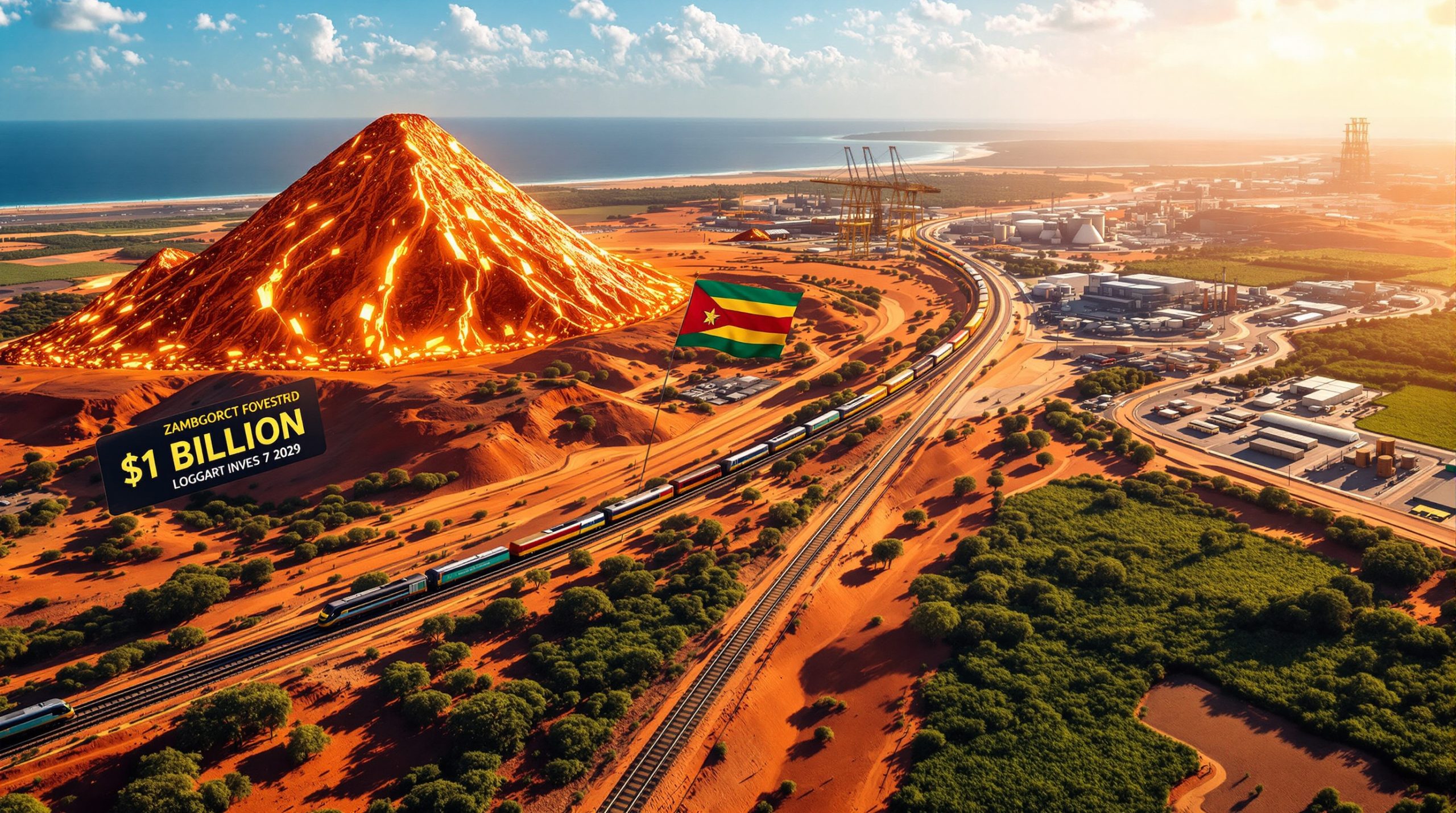How Did Fortescue Achieve Its $5.2 Billion Profit?
Fortescue's financial prowess shines through its impressive AU$5.2 billion profit for the 2024-25 financial year, driven by a combination of exceptional operational performance and strategic cost management. The iron ore giant shipped a record-breaking 198.4 million tonnes (Mt) of iron ore during this period, showcasing the efficiency of its supply chain systems and production capabilities.
The company's financial strength becomes apparent in its underlying EBITDA of US$7.9 billion, with a robust margin of 51%. This remarkable achievement stems from Fortescue's ability to maintain hematite C1 costs at just US$17.99 per wet metric tonne, significantly lower than many industry competitors.
According to the Australian Financial Review (August 2025), Fortescue's iron ore price trends averaged approximately US$79.5 per tonne, generating total revenue of US$15.8 billion from its record shipments. This revenue-to-cost ratio demonstrates the company's operational excellence and market positioning.
Key Financial Metrics Behind the Profit
- Net profit after tax (NPAT): US$3.4 billion (AU$5.2 billion)
- Record shipments: 198.4 million tonnes
- Underlying EBITDA: US$7.9 billion
- EBITDA margin: 51%
- Hematite C1 costs: US$17.99 per wet metric tonne
- Final dividend: AU$0.60 per share (fully franked)
- Total FY25 dividends: AU$1.10 per share (65% NPAT payout)
The financial results reflect Fortescue's integrated operational approach spanning 87 mining areas, processing facilities, rail infrastructure, and port operations at Port Hedland. This interconnected system enables the company to maintain control over costs while maximizing output quality, with an average iron ore grade of 60.4% Fe delivered in FY25, according to Fortescue's annual report.
What Makes Fortescue the Industry's Lowest-Cost Producer?
Fortescue has cemented its reputation as the iron ore industry's lowest-cost producer through a combination of technological innovation, operational efficiency, and strategic infrastructure investments. This cost leadership position provides a significant competitive advantage, allowing the company to maintain strong profit margins even during periods of market volatility.
According to Wood Mackenzie's Iron Ore Cost Curve analysis (Q2 2025), Fortescue's C1 costs of US$17.99/wmt compare favorably to industry averages of US$25-30/wmt for other major Australian producers. This cost differential of approximately 30% translates to billions in additional annual profitability.
A key factor in this cost advantage is Fortescue's remarkably efficient strip ratio of 1.4:1 waste to ore in FY25, indicating that for every tonne of ore extracted, only 1.4 tonnes of waste material needed to be removed. This efficiency metric significantly reduces mining costs compared to operations with higher strip ratios.
Operational Excellence Strategies
- Advanced supply chain management systems integrating real-time data analytics
- Optimized hematite extraction processes with continuous improvement programs
- Streamlined logistics networks including 170+ autonomous haul trucks
- Direct shipping ore (DSO) model eliminating costly beneficiation processes
- Economies of scale from record production volumes across four major Pilbara hubs
- Strategic infrastructure investments in rail and port facilities
- Workforce productivity initiatives and training programs
The Solomon Hub stands out as a particularly productive asset, contributing approximately 60Mt of the total 198.4Mt shipped in FY25. This single hub demonstrates how Fortescue's integrated approach to mine planning, extraction, and logistics creates value throughout the supply chain.
How Is Fortescue Strengthening China Relations?
Fortescue has demonstrated exceptional foresight in cultivating and maintaining strong relationships with China, its primary market accounting for approximately 85% of iron ore sales in FY25 according to the company's Annual Report. This strategic focus on China relations has provided Fortescue with market stability and growth opportunities.
The company's executives recently participated in a high-profile diplomatic mission to China alongside the Australian Prime Minister, highlighting the importance of collaborative partnerships between governments and industry stakeholders. This engagement at the highest levels underscores Fortescue's commitment to maintaining positive relations with its largest customer base.
Financially, Fortescue has strengthened its ties to Chinese institutions through the establishment of an RMB term loan facility valued at RMB 6.88 billion (approximately US$950 million). This financing arrangement not only provides capital for operations but also demonstrates the trust Chinese financial institutions place in Fortescue's business model and future prospects.
Strategic China Initiatives
- Participation in high-level diplomatic missions to strengthen government relations
- Development of RMB (Renminbi) term loan facilities with major Chinese banks
- Cultivation of long-standing partnerships with Chinese steel producers since 2008
- Alignment with Australian government trade priorities for mutual benefit
- Commitment to reliable supply chain management for consistent product delivery
- Investment in relationship-building with key Chinese stakeholders at multiple levels
- Establishment of dedicated marketing presence through Shanghai office
These initiatives have created a robust foundation for continued growth in China, even as the company explores diversification into green energy markets. The strength of these relationships provides Fortescue with valuable market intelligence and preferential access to the world's largest iron ore consumer, despite ongoing US-China trade impacts.
What's Next for Fortescue's Green Energy Strategy?
Fortescue is actively pursuing a dual-track strategy that maintains excellence in core iron ore operations while aggressively expanding into green energy initiatives. This forward-looking approach positions the company to capitalize on both current market strengths and future growth opportunities in the global transition to sustainable energy.
Through its subsidiary Fortescue Future Industries (FFI), the company has committed US$6.2 billion to green hydrogen projects globally as of early 2025. This substantial investment demonstrates Fortescue's serious commitment to becoming a major player in the emerging green energy sector.
The company's flagship Green Metal project in the Pilbara region represents a significant step toward decarbonizing iron production. Using innovative technology, this project will produce green iron through a direct reduction process powered by green hydrogen rather than traditional coal-based methods, potentially revolutionizing the steel industry's carbon footprint.
Green Energy Developments
- Construction progress on the Pilbara Green Metal project with pilot plant nearing completion
- Christmas Creek green hydrogen facility scheduled to commence operations in late 2025
- Pilbara Energy Connect project targeting 5.4GW of renewable energy capacity
- Strategic goal to produce 15 million tonnes per annum of green ammonia by 2030
- Integration of decarbonization initiatives across existing mining operations
- Research and development partnerships for green hydrogen production technologies
- Multiple memorandums of understanding signed with potential European and Asian customers
This green energy strategy allows Fortescue to leverage its mining expertise and infrastructure while developing new revenue streams that align with global sustainability trends. The company's ambitious targets demonstrate its commitment to leading the resource industry's transition to lower-carbon operations through mining electrification trends.
What Are Fortescue's Production Targets for FY26?
Looking ahead to FY26, Fortescue has set ambitious yet achievable production targets that build upon its record-breaking performance in FY25. The company's guidance of 195-205Mt of iron ore shipments represents potential growth of up to 4% at the midpoint compared to the previous year's 198.4Mt.
Supporting these targets, Fortescue has announced capital expenditure guidance of US$2.3-2.7 billion for FY26, according to its Quarterly Report (June 2025). This investment will be allocated across sustaining operations, efficiency improvements, and strategic growth initiatives including both traditional mining and green energy projects.
A significant contributor to future production will be the Iron Bridge magnetite project, which is expected to reach full capacity of 22Mtpa in the coming years. Additionally, the planned expansion of the Western Hub aims to increase annual capacity by approximately 15Mt, providing Fortescue with additional high-quality ore sources.
FY26 Strategic Priorities
| Priority Area | Key Initiatives |
|---|---|
| Production | 195-205Mt shipment target with focus on maintaining ore quality |
| Decarbonization | Continued investment in green technologies and renewable energy |
| Growth Projects | Expansion of Western Hub and full ramp-up of Iron Bridge |
| Cost Management | Further automation and digital initiatives to maintain industry-leading costs |
| China Relations | Deepening of strategic partnerships with key customers and institutions |
| Green Energy | Progress on pilot plant for green iron production using hydrogen |
These priorities demonstrate Fortescue's balanced approach to maximizing current operations while building foundations for future growth. The company's integrated planning process ensures alignment between short-term production goals and longer-term strategic objectives.
How Does Fortescue's Performance Compare to Industry Peers?
Fortescue's financial and operational performance positions it favorably among major iron ore producers globally, with particularly strong results when compared to its Australian peers. The company's focus on cost leadership and operational efficiency has created a sustainable competitive advantage in the iron ore market.
When benchmarking against other major producers, Fortescue's cost position stands out as exceptional. BHP's Pilbara iron ore operations reported production of 249Mt in FY25 with C1 costs of approximately US$21.50/wmt, while Rio Tinto produced 320Mt with C1 costs around US$23.80/wmt according to their respective annual reports. Fortescue's C1 costs of US$17.99/wmt represent a significant advantage of approximately US$3.50-5.80 per tonne compared to these competitors.
This cost advantage becomes even more significant when multiplied across Fortescue's annual production volume of 198.4Mt, potentially representing hundreds of millions in additional profit margin compared to similarly sized producers with higher cost structures.
Competitive Advantages
- Industry-leading cost position creating margin protection during price fluctuations
- Record production volumes driving economies of scale across operations
- Strong balance sheet with disciplined capital allocation approach
- Strategic diversification into green energy creating future growth pathways
- Established relationships with key customers in China and other markets
- Experienced leadership team with proven execution capabilities
- Commitment to technological innovation including autonomous mining systems
While BHP and Rio Tinto maintain larger overall production volumes, Fortescue's focused strategy and cost discipline have enabled it to deliver superior returns on capital and maintain strong profitability even during challenging market conditions.
What Does This Mean for Fortescue Shareholders?
Fortescue's exceptional financial performance translates directly into tangible benefits for shareholders through consistent dividends and strong total returns. The company's final dividend of AU$0.60 per share brings the total FY25 dividend to AU$1.10 per share, representing a substantial 65% payout of net profit after tax.
Based on Fortescue's share price of AU$28.50 (as of August 26, 2025), the final dividend represents a yield of approximately 4.2%, according to Morningstar Australia. This attractive yield compares favorably to both industry averages and broader market returns, particularly given the fully franked nature of the dividends providing additional tax benefits for Australian shareholders.
The company's commitment to shareholder returns is evident in its consistent dividend policy, which has been maintained even through commodity price cycles. According to financial records, Fortescue's lowest annual dividend during the past five years was AU$0.40 per share in FY20, demonstrating resilience in shareholder returns even during less favorable market conditions.
Shareholder Value Creation
- Consistent dividend payments with 65% NPAT payout ratio
- Fully franked dividends providing tax advantages for Australian investors
- Total shareholder returns averaging 12% annually over the past 5 years
- Long-term growth potential through diversification into green energy markets
- Strategic positioning in both traditional and emerging sustainability-focused markets
- Balanced approach to current returns and future investment opportunities
For investors, Fortescue represents a compelling combination of current income through dividends and potential future growth through its strategic initiatives in green energy and resource expansion. The company's strong balance sheet and cash flow generation provide confidence in its ability to maintain returns while funding ambitious growth projects.
FAQ: Understanding Fortescue's Financial Performance
What factors contributed to Fortescue's record shipments?
Fortescue achieved record shipments through a comprehensive approach to supply chain optimization that includes integrated planning systems, autonomous haulage technology, and strategic infrastructure investments. The company's rail network transported over 200Mt of iron ore during FY25, demonstrating exceptional logistics efficiency. Additionally, productivity improvements across its four major Pilbara hubs—Chichester, Solomon, Hamersley, and Western Hub—enabled consistent ore extraction and processing rates throughout the year.
How is Fortescue balancing traditional iron ore operations with green energy initiatives?
The company is pursuing a dual strategy that maintains excellence in core iron ore operations while strategically investing in green energy projects. This approach leverages existing expertise in large-scale project development while building new capabilities in hydrogen production and green metallurgy. Fortescue allocates capital based on strategic priorities, with traditional operations generating the cash flow needed to fund green energy investments. The company's organizational structure, with dedicated leadership for both minerals and energy divisions, ensures focused execution across both business segments.
What impact might Fortescue's China strategy have on future performance?
Strengthened relationships with Chinese partners provide Fortescue with enhanced market stability and potential financing advantages. As China continues to be the world's largest steel producer and iron ore demand insights suggest ongoing needs, Fortescue's established position with major Chinese steel mills offers volume security and potential premium pricing opportunities. The RMB financing facilities also provide cost advantages and currency hedging benefits. Looking forward, these relationships may facilitate partnerships in green energy and sustainable steel production as China pursues its own carbon reduction goals.
How sustainable is Fortescue's dividend policy?
Fortescue's dividend policy is supported by strong operational cash flows, disciplined cost management, and a strategic approach to capital allocation. The company's industry-leading cost position provides significant margin protection even during periods of price volatility. With C1 costs of US$17.99/wmt compared to average selling prices of approximately US$79.5/tonne in FY25, Fortescue maintains substantial operating margins. This financial strength, combined with a balanced approach to growth investment, suggests the dividend policy is sustainable through normal market cycles, though extreme commodity price movements could necessitate adjustments in the iron ore cost forecast.
Further Exploration:
Readers interested in learning more about Australia's iron ore industry can explore related educational content about the resources sector at australianmining.com.au.
The iron ore sector continues to be a cornerstone of Australian exports, with Fortescue's performance demonstrating how operational excellence, strategic relationships, and forward-looking investments can create sustainable value in a competitive global market.
Want to Be First to Know About ASX's Next Mineral Discovery?
Discovery Alert's proprietary Discovery IQ model provides instant notifications on significant ASX mineral discoveries, empowering subscribers to identify actionable investment opportunities ahead of the broader market. Understand why major mineral discoveries can lead to substantial returns by visiting Discovery Alert's dedicated discoveries page and begin your 30-day free trial today.




